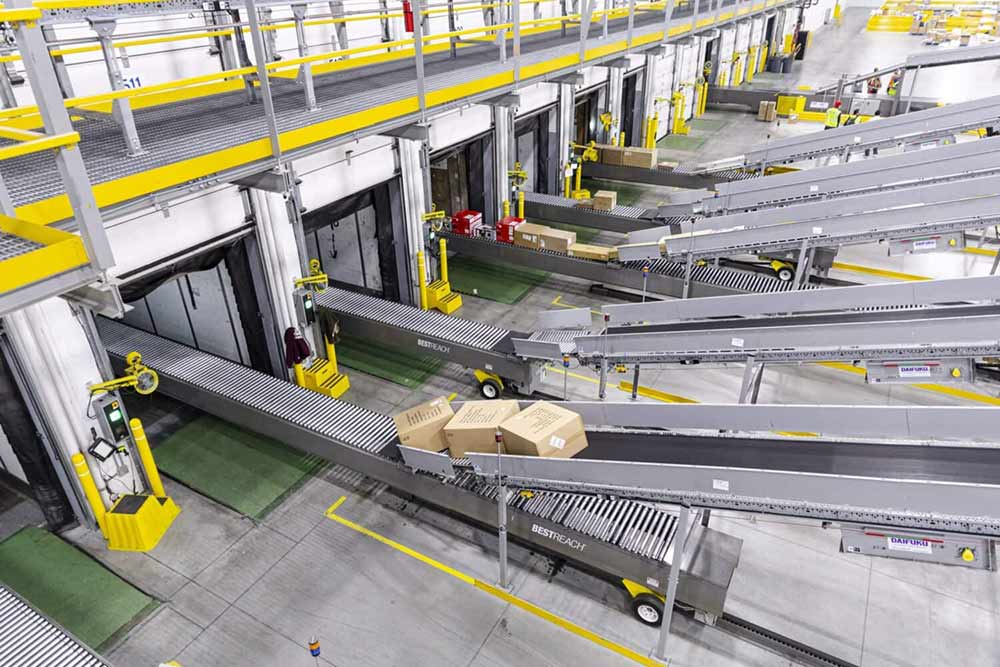The Duravant family of operating companies serve the food processing, packaging and material handling segments.
Enhancing Efficiency in the Warehouse: The Role of Fluid Truck Loading and Unloading Conveyors
11/06/2024
To meet the ever-growing demands of consumers and optimize operations, businesses are turning to technologies like truck loading and unloading conveyors. These conveyor systems, are revolutionizing how goods flow in and out of warehouses, making processes smoother and reducing labor costs. Efficiency is the powerhouse behind warehouse and distribution operations.
In the past, loading and unloading trucks was a labor-intensive ordeal, prone to errors and delays. Manual handling slowed down operations and increased the risk of injuries and incurred higher labor costs. However, with truck loading and unloading conveyors, these challenges are being overcome.

FMH Conveyors' solutions bridge the gap between the warehouse and the truck, ensuring a seamless transition of goods. Here's how they're transforming warehouse operations:
- Speed and Efficiency: These solutions significantly cut down the time needed to load and unload trucks. Unlike manual handling, which is slow and error-prone, these conveyors ensure a consistent and rapid flow of products. This increased speed not only improves turnaround times but also enables warehouses to handle higher volumes of goods, especially during peak seasons.
- Labor Savings: By automating the loading and unloading process, there is a reduced need for manual labor. This not only cuts labor costs but also minimizes the risks associated with repetitive heavy lifting, leading to a safer workplace. Employees can then focus on more value-added tasks, boosting overall productivity.
- Space Optimization: Modern systems are designed to maximize space utilization. For instance, telescopic conveyors can extend directly into the truck, requiring minimal dock space. This is especially beneficial for warehouses with limited loading bay areas, allowing for more efficient use of available space.
- Safety and Ergonomics: Workplace safety is prioritized. By reducing manual handling requirements, these conveyors minimize physical strain on workers, thus decreasing the likelihood of injuries and fostering a safer working environment. Additionally, they come equipped with safety features like emergency stops and sensors to help prevent accidents.
- Versatility: Fluid loading and unloading conveyors can handle a wide range of goods, from boxes and parcels to bulk items. They can be customized to suit different types of products and loading requirements. Whether it's fragile items or heavy packages, they can be tailored to handle various materials, making them essential in diverse industries.
- Scalability: As businesses grow, their operational needs evolve. Conveyors systems can be scalable and expanded or modified to accommodate increased volumes or changes in operational workflows. This flexibility ensures that the conveyor system can grow with the business, providing long-term value.
FMH Conveyors offers various types of truck loading and unloading conveyors, each with its own advantages:
- Telescopic Conveyors: Ideal for loading and unloading trucks and containers, these extendable conveyors reach deep into the trailer, reducing the need for manual handling.
- Roller Conveyors: Suitable for heavier loads, roller conveyors use a series of rollers to move goods along a path, making them ideal for handling large and bulky items.
- Flexible Conveyors: These conveyors can be expanded and curved to fit various loading and unloading scenarios, making them perfect for warehouses with variable workflows and space constraints.
The conveyor systems manufactured by FMH Conveyors are not just tools for enhancing efficiency in warehouses—they're essential components for a smarter, safer, and more productive future. Whether you're a small business or a large enterprise, incorporating these conveyor systems into warehouse operations brings undeniable benefits: faster processes, lower costs, and happier employees. As the industry continues to innovate, FMH Conveyors will undoubtedly remain at the forefront of warehouse automation.








